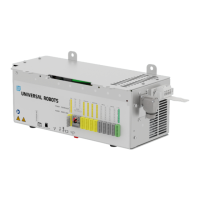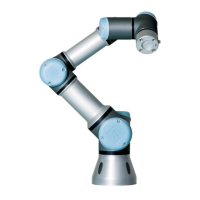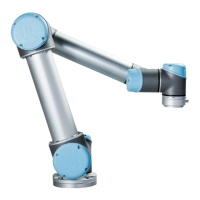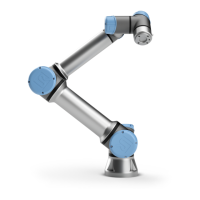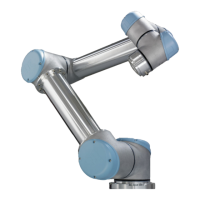SF5 Called
various
names: Pose
Limit, Tool
Limit,
Orientation
Limit, Safety
Planes,
Safety
Boundaries
Description
What
happens?
Tolerance
and PFH
D
Affects
Monitors the TCP Pose (position and
orientation) and will prevent exceeding a
safety plane or TCP Pose Limit. Multiple
pose limits are possible (tool flange, elbow,
and up to 2 configurable tool offset points
with a radius) Orientation restricted by the
deviation from the feature Z direction of the
tool flange OR the TCP. This safety function
consists of two parts. One is the safety
planes for limiting the possible TCP
positions. The second is the TCP
orientation limit, which is entered as an
allowed direction and a tolerance. This
provides TCP and wrist inclusion/ exclusion
zones due to the safety planes.
Will not allow
motion to
exceed any
limit settings.
Speed or
torques could
be reduced so
motion will not
exceed any
limit. A robot
stop will be
initiated to
prevent
exceeding any
limit. Will not
allow motion to
exceed any
limit settings.
Tol: 3° 40
mm
PFH
D
: 1.8E-
07
TCP
Tool
flange
Elbow
SF6
Speed
Limit TCP
& Elbow
Description What happens?
Tolerance
and PFH
D
Affects
Monitors the
TCP and
elbow speed
to prevent
exceeding a
speed limit.
Will not allow motion to exceed any limit settings.
Speed or torques could be reduced so motion
will not exceed any limit. A robot stop will be
initiated to prevent exceeding any limit. Will not
allow motion to exceed any limit settings.
Tol:50 mm/s
PFH
D
: 1.8E-
07
TCP
SF7
Force
Limit
(TCP)
Description What happens?
Tolerance
and PFH
D
Affects
The Force Limit is the force exerted by the
robot at the TCP (tool center point) and
“elbow”. The safety function continuously
calculates the torques allowed for each joint to
stay within the defined force limit for both the
TCP & the elbow. The joints control their
torque output to stay within the allowed torque
range. This means that the forces at the TCP
or elbow will stay within the defined force limit.
When a monitored stop is initiated by the
Force Limit SF, the robot will stop, then “back-
off” to a position where the force limit was not
exceeded. Then it will stop again.
Will not allow
motion to exceed
any limit settings.
Speed or torques
could be reduced
so motion will not
exceed any limit.
A robot stop will
be initiated to
prevent
exceeding any
limit. Will not
allow motion to
exceed any limit
settings.
Tol: 25N
PFH
D
: 1.8E-
07
TCP
User Manual 228 UR30
22.Safety Functions Table
Copyright © 2009–2024 by UniversalRobotsA/S. All rights reserved.
